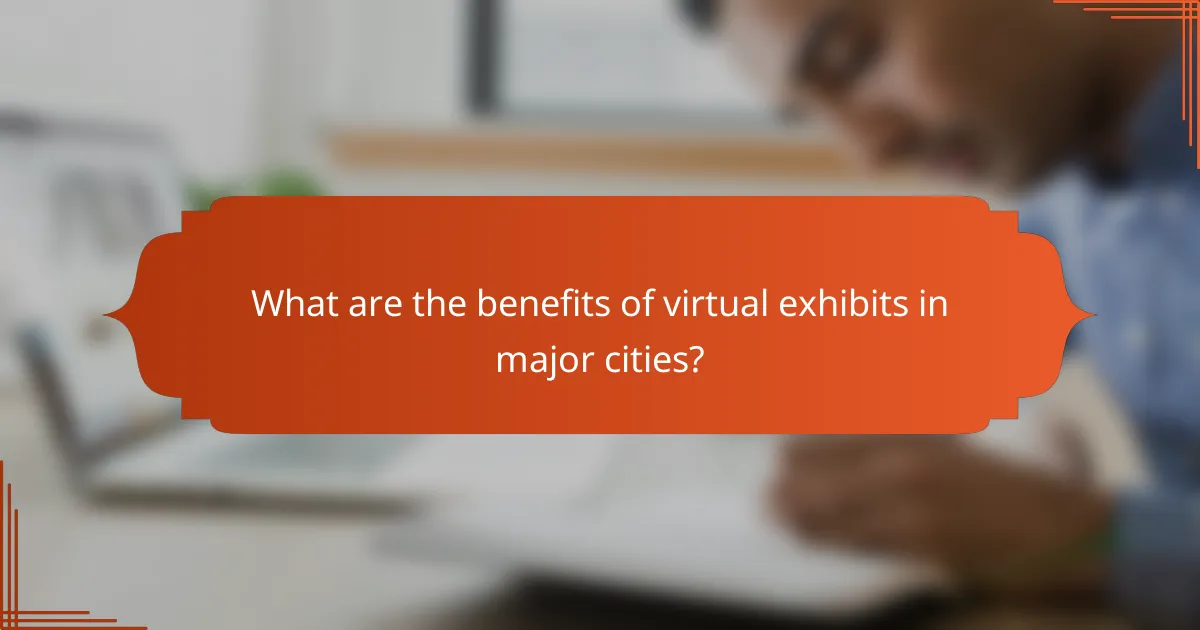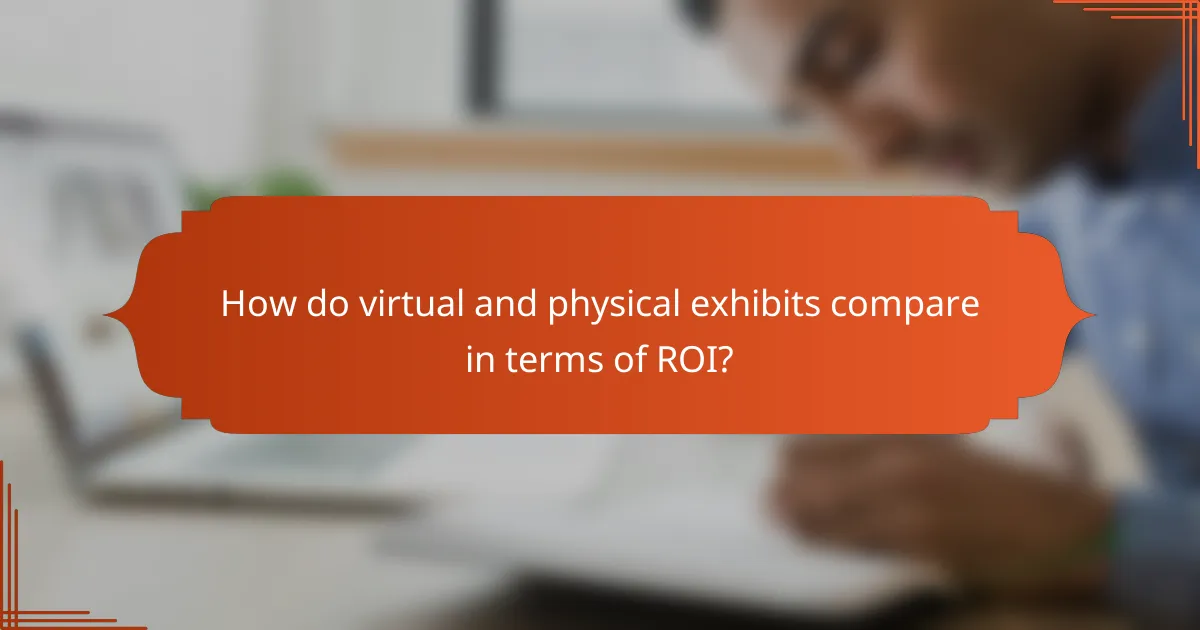In the debate between virtual and physical exhibits, each format presents distinct advantages that cater to different needs and contexts. Virtual exhibits excel in cost-effectiveness and accessibility, allowing organizations to reach a wider audience without the constraints of physical space. Conversely, physical exhibits foster immersive experiences and direct interactions, making them particularly valuable in urban settings where engagement is key. Understanding when to leverage each type can significantly enhance the impact of an exhibition.

What are the benefits of virtual exhibits in major cities?
Virtual exhibits offer significant advantages in major cities, including lower costs, broader audience engagement, and the convenience of round-the-clock access. These benefits make them an appealing choice for organizations looking to maximize impact without the limitations of physical space.
Cost-effective setup
Setting up a virtual exhibit typically requires a fraction of the budget needed for a physical exhibit. Expenses such as venue rental, transportation, and physical materials are significantly reduced or eliminated. This allows organizations to allocate funds toward high-quality digital content and marketing efforts.
For instance, while a physical exhibit in a major city might cost thousands of dollars, a virtual alternative can often be launched for a few hundred to a couple of thousand dollars, depending on the complexity of the platform used.
Wider audience reach
Virtual exhibits can attract a global audience, breaking geographical barriers that limit physical exhibits. This expanded reach allows organizations to engage with diverse demographics, increasing the potential for participation and interaction.
For example, a virtual exhibit hosted online can draw visitors from various countries, enabling organizations to connect with people who may not have been able to travel to a physical location. This is particularly beneficial for niche topics or specialized industries.
24/7 accessibility
One of the key advantages of virtual exhibits is their availability around the clock. Unlike physical exhibits that operate within specific hours, virtual platforms allow visitors to explore content at their convenience, regardless of time zone.
This continuous access can lead to higher engagement rates, as users can revisit the exhibit multiple times or explore it at their own pace. Organizations should consider promoting specific time slots for live Q&A sessions or guided tours to enhance interaction while maintaining the overall accessibility of the exhibit.

What are the advantages of physical exhibits in urban areas?
Physical exhibits in urban areas offer unique benefits that enhance visitor engagement and interaction. These advantages include immersive experiences, opportunities for networking, and direct interaction with products, making them particularly effective in densely populated settings.
Enhanced sensory experience
Physical exhibits provide a multi-sensory experience that virtual exhibits cannot replicate. Visitors can see, hear, touch, and sometimes even taste products, creating a deeper emotional connection. This sensory engagement can lead to stronger brand recall and a more memorable experience.
For example, art exhibits allow attendees to appreciate the texture and scale of artworks up close, while food festivals let participants sample dishes, enhancing their overall enjoyment and understanding of the offerings.
Networking opportunities
Physical exhibits facilitate face-to-face interactions, which can lead to valuable networking opportunities. Attendees can meet industry professionals, potential clients, and collaborators in an informal setting, fostering relationships that may not develop through virtual platforms.
Events like trade shows often include dedicated networking sessions, allowing participants to exchange contact information and discuss potential partnerships, which can be crucial for business growth.
Immediate product interaction
One significant advantage of physical exhibits is the ability for visitors to interact with products immediately. This hands-on experience allows potential customers to assess quality, usability, and fit before making a purchase decision.
For instance, technology expos often feature product demos where attendees can try out the latest gadgets, providing instant feedback and enhancing the likelihood of a purchase. This immediate interaction can significantly influence consumer behavior and drive sales.

When should you choose virtual exhibits over physical exhibits?
Virtual exhibits are ideal when budget constraints, audience reach, or time sensitivity are primary considerations. They offer flexibility and accessibility that physical exhibits may not provide, making them suitable for various scenarios.
Limited budget scenarios
When working with a limited budget, virtual exhibits can significantly reduce costs associated with venue rental, logistics, and physical materials. For instance, creating an online exhibit may only require a few hundred dollars for software and design, compared to thousands for a physical space.
Consider using platforms that offer customizable templates to minimize design expenses. This approach allows you to allocate funds toward marketing and outreach, maximizing your exhibit’s visibility without overspending.
Global audience targeting
Virtual exhibits excel at reaching a global audience without geographical limitations. They allow participants from various countries to engage with your content simultaneously, which is not feasible with physical exhibits that are location-bound.
Utilizing social media and online advertising can help you target specific demographics across different regions. For example, a virtual art exhibit can attract viewers from Europe, Asia, and the Americas, expanding your reach and potential impact.
Time-sensitive promotions
For promotions that require quick execution, virtual exhibits are often the best choice. They can be set up and launched in a matter of days, allowing you to respond rapidly to market trends or seasonal opportunities.
To maximize effectiveness, plan your virtual exhibit around specific dates or events, and use countdowns or limited-time offers to create urgency. This strategy can drive higher engagement and attendance compared to traditional physical exhibits that require longer lead times.

When are physical exhibits the better option?
Physical exhibits are often the better choice when direct interaction and tangible experiences are essential for engagement. They allow for personal connections, hands-on demonstrations, and immersive environments that virtual formats can’t fully replicate.
High-value product launches
High-value product launches benefit significantly from physical exhibits, as they create an impactful atmosphere that enhances brand perception. Attendees can experience the product firsthand, ask questions, and engage with knowledgeable staff, which can lead to stronger emotional connections and higher conversion rates.
Consider hosting these launches in venues that align with your brand’s image, such as upscale galleries or industry-specific locations. This setting not only elevates the product’s status but also attracts a targeted audience willing to invest.
Local community engagement
Physical exhibits are ideal for fostering local community engagement, as they provide a platform for direct interaction with the audience. Local events allow businesses to build relationships, gather feedback, and create a sense of belonging among community members.
To maximize impact, consider partnering with local organizations or hosting events in familiar venues. This strategy can enhance visibility and encourage participation, ultimately strengthening community ties and brand loyalty.
Trade shows and conventions
Trade shows and conventions are prime opportunities for physical exhibits, as they gather industry professionals and potential customers in one location. These events facilitate networking, knowledge sharing, and competition analysis, making them invaluable for businesses looking to expand their reach.
When participating in trade shows, ensure your exhibit is visually appealing and interactive to attract attendees. Offering demonstrations, giveaways, or exclusive promotions can also enhance engagement and leave a lasting impression on visitors.

How do virtual and physical exhibits compare in terms of ROI?
Virtual and physical exhibits offer different returns on investment (ROI) based on various factors such as target audience, engagement levels, and operational costs. Virtual exhibits typically have lower upfront costs and can reach a wider audience, while physical exhibits often provide more immersive experiences but require significant investment in logistics and space.
Virtual exhibit cost analysis
Virtual exhibits generally incur lower costs compared to physical ones. Expenses may include software platforms, design services, and digital marketing, which can range from a few hundred to several thousand dollars depending on complexity. Additionally, ongoing costs like hosting and maintenance should be considered.
One advantage of virtual exhibits is the ability to scale without significant additional costs. For instance, reaching thousands of attendees online can be achieved with minimal incremental expense, unlike physical exhibits where each additional visitor may increase costs for space and materials.
Physical exhibit investment returns
Physical exhibits often require a substantial initial investment, including venue rental, booth construction, and transportation of materials. These costs can range from thousands to tens of thousands of dollars, depending on the scale and location of the event. However, they can generate high engagement and lead conversion rates, particularly in industries where personal interaction is crucial.
To maximize ROI from physical exhibits, businesses should focus on strategic location selection and effective pre-event marketing. Engaging presentations and interactive elements can enhance visitor experience, leading to stronger connections and potential sales. Tracking metrics like lead generation and post-event follow-ups is essential to evaluate the effectiveness of the investment.
